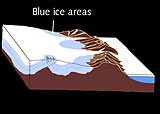Antarctic meteorites
More meteorites have been recovered from Antarctica than from any other place on Earth. The Antarctic is an ideal location to collect meteorites because they are actually concentrated by the action of the ice and can survive for millions of years.

A diagram illustrating the formation of blue ice areas.
Preserved by the Ice
When a meteorite falls in Antarctica it becomes buried under snow and will eventually become incorporated into the deep ice cap.
The ice cap in Antarctica is continually flowing to the edge of the continent, carrying the meteorites with it. When the ice hits a barrier, such as a mountain range, it is forced upwards.
The strong 'katabatic' (downward) winds erode the surface ice, revealing high pressure 'blue ice' and the meteorites it has brought up from great depths. The meteorites accumulate, as they are too heavy to be carried far by the wind.
Meteorites found in the Antarctic are the oldest

Collecting meteorites in Antarctica with ANSMET.
As Antarctica is extremely cold, generally below freezing, it is very dry. The lack of moisture means that meteorites weather incredibly slowly and can survive longer than anywhere else on Earth.
The oldest meteorite collected in Antarctica has a terrestrial residence age of over 2.5 million years.
Scientists have noticed that the really old meteorites from Antarctica differ from more recent finds, suggesting that the number and type of meteorites has changed over the last 2 million years.
Expeditions
Both the USA and Japan organise expeditions to collect meteorites in the Antarctic each year and between them have found many thousands of meteorites. Several scientists working at the Natural History Museum, including Dr Sara Russell and Dr Gretchen Benedix, have collected meteorites in the Antarctic with the United States Antarctic Search for Meteorites (US ANSMET) team.
Toolbox

There are 27 km of specimen shelves in the Darwin Centre - the same distance as between the Museum and Junction 6 of the M1.